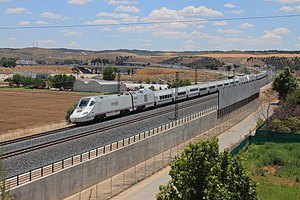
Talgo, S.A. is a Spanish manufacturer of intercity, standard, and high speed passenger trains.

Alta Velocidad Española (AVE) is a service of high-speed rail in Spain operated by Renfe, the Spanish national railway company, at speeds of up to 310 km/h (193 mph). As of August 2017, the Spanish AVE system is the longest HSR network in Europe with 3,240 km (2,010 mi) and the second longest in the world, after China's.

The Madrid–Barcelona high-speed rail line is a 621-kilometre (386 mi) standard gauge railway line inaugurated on 20 February 2008. Designed for speeds of 350 km/h (217 mph) and compatibility with neighbouring countries' rail systems, it connects the cities of Madrid and Barcelona in 2 hours 30 minutes. In Barcelona the line is connected with the Perpignan–Barcelona high-speed rail line leading into France which connects it to the European high speed network.

The AVE Class 100, or Series 100, is a high-speed train used for AVE services by the Renfe Operadora, in Spain. It was the first high-speed train put into service in Spain, in 1992.

The AVE Class 102 or S-102 is a high-speed train used for the AVE service and operated in Spain by the state-run railway company RENFE, and based on Bombardier Transportation's power car technology. Outside AVE service, Talgo markets this train as the Talgo 350.

The RENFE Series 333 are high power six-axle diesel-electric locomotives built in the 1970s; at the time of their introduction they were the most powerful non-electric locomotives in Spain.
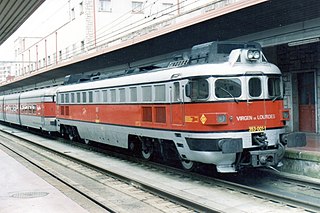
The RENFE Class 353, formerly known as the T-3000 are a class of diesel-hydraulic locomotives built by Krauss-Maffei for express trains in Spain.

The RENFE Class 352 was a class of twin engined four axle diesel-hydraulic locomotives built by Krauss-Maffei, designed solely for passenger traffic; in particular they were responsible for towing Andalusian Talgo III trains. The class were very successful, heralding a new era of passenger trains in Spain. They were delivered in 1964 and 1965, and were fully withdrawn during the 1990s.

The RENFE Class 354 was a series of eight diesel hydraulic locomotives manufactured by Krauss-Maffei in Germany specifically to pull Talgo pendular coaches which were introduced shortly before the acquisition of these machines.

Alvia is a high-speed train service in Spain used by Renfe Operadora for long-distance service with a top speed of 250 km/h. The trains have the ability to use both Iberian gauge and standard gauge, which allows them to travel on the recently constructed high-speed lines for part of the journey before switching to the ″classic″ Iberian gauge network to complete it. Trains that run exclusively on high-speed tracks are branded AVE or Avant.
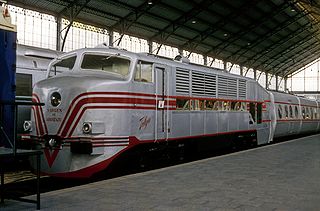
The RENFE Class 350 is a series of four single-cabin diesel locomotives that were delivered to Spain in 1950 for use with Talgo II coaches, being built in the USA by the American Car and Foundry company to a distinctly American external style.

The RENFE Class 130 or S-130 is a high-speed dual-gauge, dual-voltage trainset consisting of 11 Talgo VII tilting coaches and two power cars, used on Alvia services. The class have been nicknamed patitos (ducklings), due to the shape of the train nose.
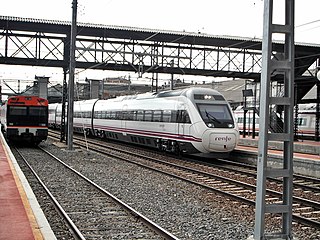
The RENFE Class 120 are electric multiple units used on Alvia high-speed rail services in Spain. Based on a family trains CAF Cepia.

The Madrid–León high-speed rail line was inaugurated on 29 September 2015. The line is built to standard gauge and gauge changers are provided at strategic points to allow interchange with older Spanish railways which were built to Iberian gauge.

Talgo Avril is a high-speed train that Talgo is developing. It stands for "Alta Velocidad Rueda Independiente Ligero".

The RENFE classes 319.2, 319.3 and 319.4 are six axle Co'Co' medium power mainline diesel-electric locomotives manufactured by Macosa using General Motors Electromotive division components under license.

Oaris is a modular high-speed train platform developed by the Spanish manufacturer CAF.

The Catalan Talgo was an international express train introduced in 1969 that linked Geneva, Switzerland, with Barcelona, Spain. It was named after the Spanish region Catalonia and the Talgo equipment it used. It was an extension and upgrading of a predecessor train, Le Catalan, a first-class-only French (SNCF) Rapide train that had been in operation since 1955 but running only between Geneva and the stations nearest the Spanish-French border, connecting with a second-class-only "autorail" trainset to and from Barcelona. The national railway network of Spain, Red Nacional de los Ferrocarriles Españoles (RENFE), was using Iberian gauge for all of its main lines, while those of France and Switzerland use standard gauge. As a result of this break-of-gauge, train journeys between Geneva and Barcelona consisted of two separate parts, with travelers having to change from a French to a Spanish train or vice versa at the border—at Portbou on southbound trains and at Cerbère on northbound trains. In 1968, this was resolved with the introduction of the Talgo III RD trainsets, which featured variable gauge wheelsets. At Portbou station, the wheel spacing of each passenger carriage was adjusted by a gauge changer for the difference in gauge, and passengers no longer had to change trains. After successful test runs, the Catalan was extended from Port Bou to Barcelona as a through train on 1 June 1969, becoming the Catalan Talgo and upgraded to a Trans Europ Express (TEE). Most other rail journeys through this border crossing continued to require a change of train at Cerbère station or at Port Bou, as most trains did not use Talgo III RD trainsets.
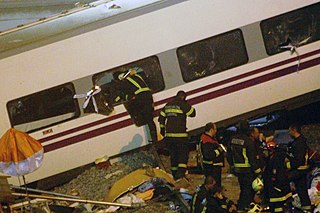
The Santiago de Compostela derailment occurred on 24 July 2013, when an Alvia high-speed train traveling from Madrid to Ferrol, in the north-west of Spain, derailed at high speed on a bend about 4 kilometres (2.5 mi) outside of the railway station at Santiago de Compostela. Out of 222 people on board, around 140 were injured and 79 died.

CAF Sepia is a family of high-speed electric multiple unit trains built by CAF and used in Spain and Turkey. The Sepia is based on the Class 120 high-speed trains manufactured by CAF for the Renfe Operadora (RENFE). The Renfe Operadora was the first to order CAF high speed trains; it ordered 12 of these units in 2001, the Turkish State Railways (TCDD) 12 units. The trains were delivered in 2004 for service. The trains were labelled and marketed as the Sepia by their manufacturer, CAF.
